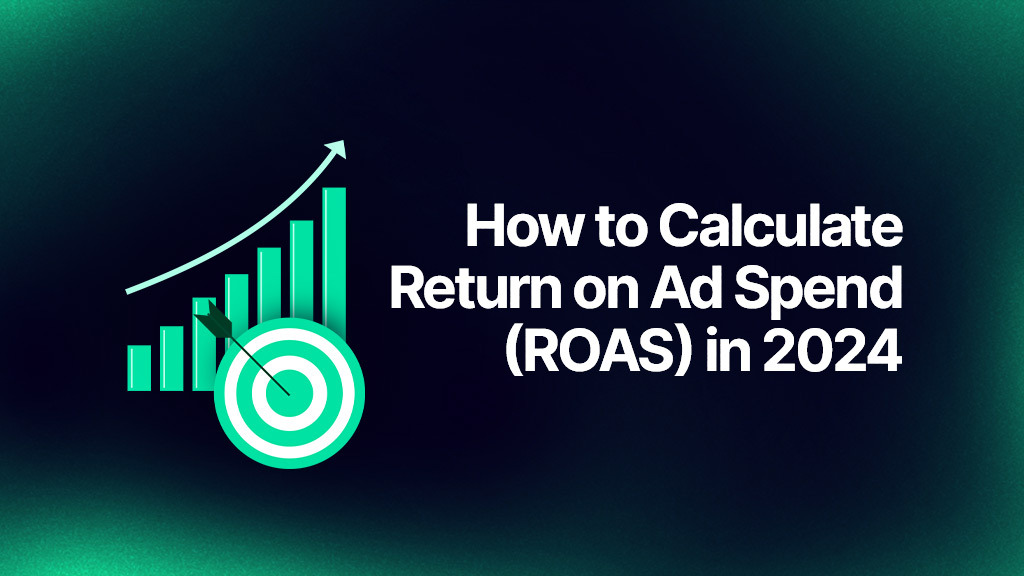How to Calculate Return on Ad Spend (ROAS) in 2025 with Benchmarks

Table of Contents
- How to Calculate ROAS
- What Is a Good ROAS?
- What Is the Difference Between ROAS and ROI?
- How Do You Improve Your ROAS?
- How to Determine Revenue Attribution to Calculate ROAS
- Why Does ROAS Calculation Matter?
What does ROAS mean? Nowadays, businesses are constantly seeking ways to measure the effectiveness of their ad campaigns. One of the most critical metrics for evaluating campaign performance is Return on Ad Spend (ROAS).
As we move through 2025, accurately calculating ROAS and understanding industry benchmarks can help businesses increase the effect of their ad budgets. Whether you’re looking to assess the profitability of your campaigns or perform better ad optimization for better results, mastering ROAS in marketing is key.
Here, we’ll explore what does ROAS stand for, how to calculate return on ad spend, what is a good ROAS, and actionable strategies to improve it.
How to Calculate ROAS
ROAS calculation is simple, but it’s important to understand the ROAS formula and make sure you’re tracking the right data. The ROAS calculation formula is:
ROAS = Cost of Ads / Revenue from Ads
Here’s how it works:
- Revenue from Ads: This is the total revenue generated from the sales attributed to your ad campaigns.
- Cost of Ads: This includes all the expenses directly related to running your ads, such as the amount spent on ad placements.
For example, if you spent $1,000 on an ad campaign and it generated $5,000 in sales, your ROAS would be:
5,000 / 1,000 = 5
This means for every money spent on digital ads, you earned five dollars in revenue, resulting in a ROAS of 5:1.
While the basic return on ad spend formula is simple, accurately calculating ROAS requires precise tracking of ad costs and revenue attribution. Make sure to account for all ad expenses and use the appropriate attribution models to ensure you’re measuring the true impact of your campaigns.
What Is a Good ROAS?
Well, it’s a tricky question. A “good” ROAS depends on your industry, advertising goals, and the overall cost structure of your business. Generally speaking, a ROAS of 4:1 (or 400%) is considered a strong benchmark. This means that for every $1 spent on advertising, you generate $4 in revenue. However, what’s considered good can differ:
E-commerce businesses often aim for higher ROAS metrics, typically above 4:1, due to lower profit margins and higher competition. On the other hand, service-based businesses may find a lower ROAS acceptable, especially if they have a higher lifetime customer value (LTV) or if their sales cycles are longer.
Profit margins, customer acquisition costs, and long-term value are all critical aspects to consider when setting ROAS goals. While a high ROAS might seem ideal, maintaining profitability and scalability in the long run is key.
What Is the Difference Between ROAS and ROI?

While both ROAS (Return on Ad Spend) and ROI (Return on Investment) are used to measure the effectiveness of digital ads and business investments, they measure different aspects of performance and serve different purposes. Let’s break them down:
ROAS (Return on Ad Spend)
What does ROAS mean in marketing? ROAS is a metric used to evaluate the effectiveness of your advertising efforts in terms of revenue generated from ads. It focuses primarily on the relationship between the money spent on ads and the revenue it brings in. The formula for ROAS is:
ROAS = Revenue from Ads / Cost of Ads
Key Points About ROAS:
- Narrow Focus: ROAS focuses only on the performance of your ad spend, not the overall profitability of your business.
- Efficiency Metric: It shows how efficiently your ads generate revenue but doesn’t include other costs such as production, salaries, or overhead.
- Ad-Specific: It’s useful for measuring and optimizing individual ad campaigns or channels.
ROI (Return on Investment)
ROI, on the other hand, is a broader profitability metric that evaluates the overall return from all investments, including ad spend, production costs, operational costs, and other expenses. The formula for ROI is:
ROI = Net Profit / Total Investment × 100
Key Points About ROI:
- Comprehensive View: ROI considers all costs, not just ad spend. This includes production, marketing, distribution, and operational expenses.
- Profitability Metric: It tells you whether the total investment, not just ads, is profitable.
- Business-Wide Application: ROI is used to measure the performance of a business as a whole, specific products, or larger projects, rather than individual ad campaigns.
Key Differences Between ROAS and ROI
- Scope:
ROAS focuses only on the revenue generated from ads in relation to the cost of running those ads. However, ROI considers all costs associated with producing and selling a product or service, not just the advertising expenses.
- Purpose:
ROAS evaluates ad efficiency, how much revenue your ads directly generate. On the other hand, ROI measures overall profitability, factoring in expenses beyond just ads to give a comprehensive view of financial performance.
- Use Case:
ROAS is ideal for optimizing ad spend and tracking the performance of specific advertising campaigns. If your goal is to understand how well your ads are performing, ROAS is the go-to metric. ROI is useful for evaluating the profitability of wider business initiatives. It helps businesses assess whether their entire investment, including ads, production, and other costs, is generating profit.
- Insights:
ROAS can tell you if your ad spend is driving revenue but not if your campaign is profitable after accounting for all business expenses. ROI provides a complete view of whether your total investment is profitable, not just your ad spend.
When to Use ROAS vs. ROI
Use ROAS when you want to:
- Analyze the effectiveness of individual ad campaigns or channels.
- Measure how efficiently your advertising dollars are turning into revenue.
- Optimize ad performance by comparing campaigns and adjusting budgets.
Use ROI when you want to:
- Assess the overall profitability of your business, product, or initiative.
- Measure the long-term viability of a project by considering all associated costs.
- Make broader financial decisions that involve multiple aspects of your business beyond advertising.
To sum up, ROAS helps you understand the direct impact of your ad spend, while ROI provides a holistic view of your business profitability. For advertisers and marketers, tracking both metrics is essential to balancing ad efficiency with overall profitability, ensuring your advertising strategies support sustainable business growth.
How Do You Improve Your ROAS?

Improving your Return on Ad Spend (ROAS) requires a combination of strategic planning, optimization, and continuous testing. Let’s look at the key strategies to help boost your ROAS and get the most out of your ad budget:
1. Improve Your Audience Targeting
One of the most effective ways to improve ROAS is to ensure your ads are displayed to the right audience. Narrowing your targeting to people who are most likely to convert can significantly reduce wasted ad spend. Here’s how you can refine your audience targeting:
Demographic and Geographic Targeting: Tailor your ads based on age, gender, location, and interests to reach the most relevant audience.
Behavioral Targeting: Use data on user behavior, such as previous purchases, website visits, or product views, to focus on potential customers already showing interest in your products.
Lookalike Audiences: Create lookalike audiences based on your highest-converting customers to find new, similar potential customers who are likely to convert.
2. Optimize Ad Creatives
Your ad creative plays an important role in how well your ads perform. Testing and optimizing your creative elements can lead to higher click-through and conversion rates, finally improving your ROAS. Focus on:
Attractive Visuals: Use high-quality images or videos that grab attention and connect with your target audience.
Clear and Concise Messaging: Make sure your ad copy is clear, concise, and focused on the benefits of your product or service. Use a strong call-to-action (CTA) to increase conversions.
A/B Testing: Continuously test different versions of your ads to identify which images, headlines, CTAs, and formats perform best. Run A/B tests to optimize for higher engagement and conversions.
3. Take Advantage of Automated Bidding Strategies
Using automated bidding strategies, especially on platforms like Google Ads and Meta (Facebook), can help improve your ROAS by optimizing bids in real-time based on user behavior and predicted performance. Consider these options:
Target ROAS Bidding: Platforms like Google Ads allow you to set a target ROAS, automatically adjusting bids to help you achieve that goal.
Smart Bidding: Tools like Google’s Smart Bidding use machine learning to optimize bids for conversions, helping you maximize results without manual intervention.
Bid Adjustments: Experiment with bid adjustments for factors such as time of day, device, and location to ensure your ads appear in the most profitable contexts.
4. Utilize Audience Segmentation and Retargeting
Well, not all customers are at the same stage of the buying journey. Segmenting your audience and customizing your ads to different groups can help improve relevancy and increase conversion rates:
Audience Segmentation: Divide your audience based on behavior, demographics, and purchase intent. Create tailored ads for each segment, whether they’re new visitors, returning customers, or loyal buyers.
Retargeting: Use retargeting ads to reach people who have already interacted with your brand, whether they visited your website, viewed a product, or abandoned their cart. Retargeting is often more cost-effective, as these users have already shown interest in your product.
5. Use Leverage Cross-Channel Marketing
Don’t limit yourself to a single platform. Diversifying your ad spend across multiple channels (Google Ads, Meta Ads, TikTok, etc.) allows you to reach different audiences and test where you get the best returns:
Cross-Channel Tracking: Use tools to track performance across channels and identify where your highest ROI and ROAS come from.
Attribution Models: Utilize multi-touch attribution to better understand the entire customer journey and allocate credit to multiple touchpoints, which helps in optimizing spend across channels.
By implementing these strategies, you can improve your ROAS and maximize the return on your ad investment, driving higher profitability while reducing waste. Effective ROAS optimization is a continuous process of testing, learning, and refining your campaigns to adapt to changing market conditions and consumer behavior.
How to Determine Revenue Attribution to Calculate ROAS

Accurately determining revenue attribution is important when calculating ROAS, as it helps ensure that the revenue you associate with your ad spend is correct. Revenue attribution refers to the process of assigning the correct share of sales revenue to the specific ad, campaign, or channel that led to the conversion.
Without accurate attribution, your ROAS calculations may be skewed, leading to misguided insights.
1. Choose the Right Attribution Model
Different attribution models assign credit for conversions in different ways, and choosing the right one for your business is critical. Common attribution models include:
- Last-Click Attribution: All the credit for a conversion goes to the last ad or interaction the customer engaged with before making a purchase. This is the simplest model but can undervalue earlier interactions.
- First-Click Attribution: The first ad or interaction that led the customer to your business receives all the credit. This can be useful for understanding the effectiveness of initial touchpoints, but it ignores subsequent engagements.
- Linear Attribution: Credit is distributed equally across all touchpoints in the customer journey. This model gives a more balanced view of all interactions leading to the conversion.
- Time-Decay Attribution: More credit is given to touchpoints closer to the conversion, recognizing the increasing importance of interactions as they get nearer to the sale.
- Position-Based Attribution: Often referred to as the U-shaped model, 40% of the credit is given to both the first and last touchpoints, while the remaining 20% is spread across interactions in between.
It worth to note that choosing the right model depends on your sales cycle and business goals. For example, businesses with long sales cycles may benefit from a time-decay model, while ecommerce brands with quick purchase decisions may favor last-click attribution.
2. Use Tracking Tools and Analytics Platforms
To accurately attribute revenue to specific ads or campaigns, you’ll need the right tracking tools. Platforms like Google Ads, Meta Ads, and third-party tools like Google Analytics, WASK and more offer detailed attribution reports to help you understand which channels, ads, and keywords are increasing conversions.
Use UTM tags in your URLs to track the source of website traffic and revenue back to individual campaigns, ads, or social posts. This helps ensure that revenue is accurately tied to the right ad.
Pixels (such as the Facebook Pixel or Google Tag Manager) are small snippets of code that track user behavior on your website, such as page views, purchases, and cart abandonment. These tools help you attribute online conversions to your ads.
If you run ads across multiple platforms, it’s essential to use a cross-channel attribution tool to prevent over- or under-crediting certain platforms.
3. Track the Full Customer Journey
To get accurate revenue attribution, you need visibility into the entire customer journey. This involves tracking interactions across multiple touchpoints (such as social media, search engines, and email campaigns) and assigning revenue proportionally based on those interactions.
Instead of giving all the credit to a single touchpoint, multi-touch attribution models assign portions of the revenue across the customer journey. This helps you see the bigger picture and understand the role each channel plays in increasing conversions.
You can integrate CRM systems into your ad campaigns to provide more detailed customer journey data, allowing you to tie revenue more accurately to specific interactions over time.
4. Use Advanced Attribution Solutions for Complex Journeys
For businesses with long or complex sales cycles, where multiple touchpoints are involved over a period of time, basic attribution models may not provide enough detail.
Advanced attribution solutions, such as data-driven attribution models powered by machine learning, can automatically assign credit based on the actual impact each interaction has on conversion outcomes.
These solutions consider multiple variables, such as the order of interactions, the device used, and the time between touchpoints, to provide more accurate and customized attribution for each campaign.
Example of Revenue Attribution for ROAS Calculation
Let’s say you ran a $5,000 ad campaign across Google Ads and Facebook Ads, and it generated the following:
Google Ads: $7,000 in revenue from 100 conversions
Meta Ads: $3,000 in revenue from 50 conversions
Using a multi-touch linear attribution model, where both platforms contributed to conversions, you might assign:
50% of each conversion to the platform responsible for the first click.
50% of each conversion to the platform responsible for the last click.
This means:
Google Ads would be credited with $5,000 in revenue.
Meta Ads would be credited with $5,000 in revenue.
Now you can calculate return on ad spend for each platform:
Google Ads ROAS: $5,000 / $3,000 = 1.67
Meta Ads ROAS: $5,000 / $2,000 = 2.5
Accurately attributing revenue like this helps ensure you’re measuring the true impact of your campaigns, leading to more effective optimization and budget allocation.
Proper revenue attribution is key to ensuring accurate ROAS calculations. By using the right attribution model and tracking tools, you can get a clear picture of which ads and campaigns are driving revenue, allowing you to make more informed decisions about how to optimize your advertising strategy.
Why Does ROAS Calculation Matter?
Calculating Return on Ad Spend (ROAS) is important for any business running digital ad campaigns because it directly measures the effectiveness and profitability of your marketing efforts. Here are the key reasons why ROAS calculation matters:
1. Evaluate Campaign Performance
ROAS metric serves as a clear sign of how well your ad campaigns are performing. It tells you whether the revenue generated from your ads justifies the investment you’re making.
For example, a ROAS of 4:1 means that for every dollar spent on ads, you’re generating $4 in revenue. If your ROAS is lower than expected, it may be time to reconsider your ad strategies, creatives, targeting, or budget allocation.
2. Optimize Budget Allocation
A clear understanding of ROAS allows you to make data-driven decisions when allocating your ad budget. By knowing which campaigns or channels deliver the highest returns, you can shift your spending toward the most profitable options. This helps maximize the effectiveness of your digital ads efforts while minimizing wasted spend.
3. Improve Profitability
ROAS isn’t just about measuring revenue; it’s about understanding profitability. A high ROAS generally indicates that your ads are contributing positively to your bottom line, while a low ROAS suggests that your ad spend may be outweighing the profits.
Tracking ROAS allows you to optimize for more cost-effective results and ensures your campaigns are contributing to overall profitability.
4. Set Realistic Benchmarks and Goals
Understanding your ROAS helps you set realistic benchmarks and performance goals for future campaigns. It provides a reference point for evaluating whether your marketing efforts are meeting expectations, underperforming, or exceeding your goals. Based on these insights, you can adjust your strategies and set more accurate growth targets.
Understanding what ROAS is and calculating Return on Ad Spend (ROAS) is important for optimizing your digital marketing strategy in 2025. By knowing what a good ROAS is, how it differs from ROI, and how to improve it, you can make data-driven decisions to maximize profitability and efficiency.
Accurately determining revenue attribution and consistently tracking your ROAS across campaigns helps you allocate your budget more effectively and set realistic benchmarks for success. Mastering ROAS allows you to get the most out of your ad spend and drive sustainable growth for your business.




